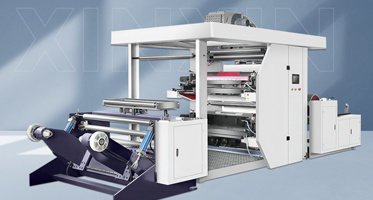31
2024
-
12
Understanding the Benefits of Hydraulic Shaftless Unwinding in Manufacturing
Author:
Understanding the Benefits of Hydraulic Shaftless Unwinding in Manufacturing
Manufacturing processes are evolving, and with them, the technologies that drive efficiency and productivity. One such innovation making waves in the industry is **hydraulic shaftless unwinding**. This advanced technology offers a range of benefits, from improved operational efficiency to enhanced product quality. In this article, we will delve into the various aspects of hydraulic shaftless unwinding, exploring its advantages and applications in modern manufacturing.
Table of Contents
- 1. Introduction to Hydraulic Shaftless Unwinding
- 2. How Hydraulic Shaftless Unwinding Works
- 3. Key Benefits of Hydraulic Shaftless Unwinding
- 4. Applications in Various Industries
- 5. Hydraulic Shaftless Unwinding vs. Traditional Methods
- 6. Overcoming Challenges in Implementation
- 7. Future Trends in Hydraulic Unwinding Technology
- 8. FAQs about Hydraulic Shaftless Unwinding
- 9. Conclusion
1. Introduction to Hydraulic Shaftless Unwinding
Hydraulic shaftless unwinding is a revolutionary method used in manufacturing processes to unwind and feed materials to machinery. Unlike traditional methods that require shafts and spindles, hydraulic shaftless unwinding utilizes hydraulic systems to facilitate material handling. This technology is particularly valuable in industries such as **printing, packaging, and converting**, where large rolls of material are used.
As manufacturing demands evolve, the need for more efficient and reliable methods of unwinding materials has become evident. This is where hydraulic shaftless unwinding comes into play.
2. How Hydraulic Shaftless Unwinding Works
The operation of hydraulic shaftless unwinding is driven by hydraulic power, enabling smooth and controlled unwinding of materials. The system is composed of several key components, including:
- **Hydraulic Cylinders**: These are responsible for the movement and tensioning of the unwinding roll, providing precise control over the material feed.
- **Roller Supports**: These platforms hold the material roll in place, allowing for effortless unwinding without the need for a shaft.
- **Control Systems**: Advanced control panels enable operators to monitor and adjust the unwinding process, ensuring optimal performance.
The absence of a shaft in this unwinding method minimizes mechanical complexity, leading to less maintenance and improved reliability. Additionally, this design allows for faster changeovers, making it ideal for high-volume production environments.
3. Key Benefits of Hydraulic Shaftless Unwinding
Implementing hydraulic shaftless unwinding in manufacturing processes offers numerous advantages:
3.1 Enhanced Efficiency
Hydraulic shaftless unwinding significantly increases the efficiency of material handling. With the ability to unwind materials smoothly and at controlled speeds, manufacturers can achieve higher throughput rates. This efficiency translates into shorter production cycles and quicker time-to-market for products.
3.2 Reduced Downtime
Traditional unwinding methods often lead to increased downtime due to mechanical failures or the need for frequent adjustments. The hydraulic system's reliability minimizes such interruptions, ensuring continuous operation and maximizing productivity.
3.3 Improved Material Handling
The design of hydraulic shaftless unwinding systems accommodates various material types and sizes. This flexibility allows manufacturers to handle a wide range of materials, from thin films to heavy-duty substrates, without compromising performance.
3.4 Enhanced Safety
Safety is a paramount concern in manufacturing environments. Hydraulic shaftless unwinding systems reduce the risk of accidents associated with traditional methods, such as injuries from rotating shafts. The controlled operation of hydraulic systems promotes a safer workplace.
3.5 Cost-Effectiveness
Investing in hydraulic shaftless unwinding technology can lead to significant long-term cost savings. The reduced maintenance requirements, lower operational costs, and increased productivity contribute to a favorable return on investment.
4. Applications in Various Industries
Hydraulic shaftless unwinding finds applications across a multitude of industries, including:
4.1 Printing Industry
In the printing industry, hydraulic shaftless unwinding is used for handling rolls of paper, film, and other substrates. The precision and control offered by this technology enhance print quality and reduce waste.
4.2 Packaging Sector
The packaging industry benefits from hydraulic unwinding systems by facilitating the smooth feeding of materials into packaging machines. This results in efficient packaging processes and improved product presentation.
4.4 Converting Industry
Converting industries that process materials into finished products leverage hydraulic shaftless unwinding for consistent and precise material handling, ensuring high-quality output.
5. Hydraulic Shaftless Unwinding vs. Traditional Methods
When comparing hydraulic shaftless unwinding to traditional unwinding methods, several key differences emerge:
5.1 Complexity
Traditional unwinders rely on complex mechanical components that can wear out and require frequent maintenance. In contrast, hydraulic systems simplify the process, reducing the likelihood of mechanical failures.
5.2 Flexibility
Hydraulic shaftless systems offer superior flexibility in accommodating various roll sizes and materials, making them suitable for diverse manufacturing needs.
5.3 Speed
The hydraulic operation allows for quicker changeovers and faster unwinding speeds, enhancing overall production efficiency compared to traditional systems.
6. Overcoming Challenges in Implementation
While the benefits of hydraulic shaftless unwinding are compelling, some challenges may arise during implementation:
6.1 Initial Investment
The upfront cost of adopting hydraulic systems can be higher than traditional methods. However, manufacturers should consider the potential long-term savings and productivity gains.
6.2 Training Requirements
Transitioning to hydraulic systems may require staff training to ensure proper operation and maintenance. Investing in training programs can mitigate this challenge.
6.3 Integration with Existing Systems
Integrating hydraulic shaftless unwinding into existing manufacturing processes may require adjustments. Collaboration with equipment suppliers can facilitate a smooth transition.
7. Future Trends in Hydraulic Unwinding Technology
As technology continues to advance, the future of hydraulic shaftless unwinding looks promising. Some trends to watch for include:
7.1 Automation
The integration of automation in hydraulic unwinding systems will further enhance efficiency, allowing for real-time monitoring and data analytics to optimize performance.
7.2 Smart Technology
The emergence of Industry 4.0 has led to the development of smart hydraulic systems that utilize IoT technology for predictive maintenance, reducing downtime and enhancing reliability.
8. FAQs about Hydraulic Shaftless Unwinding
8.1 What is hydraulic shaftless unwinding?
Hydraulic shaftless unwinding is a method of unwinding materials in manufacturing processes using hydraulic power instead of traditional shafts.
8.2 What industries benefit from hydraulic shaftless unwinding?
Industries such as printing, packaging, and converting benefit from hydraulic shaftless unwinding due to its efficiency and versatility.
8.3 How does hydraulic shaftless unwinding improve safety?
By eliminating rotating shafts and minimizing mechanical complexities, hydraulic shaftless unwinding reduces the risk of accidents and enhances workplace safety.
8.4 Is hydraulic shaftless unwinding cost-effective?
Yes, while the initial investment may be higher, the long-term savings in maintenance, operational costs, and increased productivity make it a cost-effective solution.
8.5 Can hydraulic shaftless unwinding handle different material types?
Absolutely. Hydraulic shaftless unwinding systems are designed to accommodate a wide range of materials, providing flexibility in handling various substrates.
9. Conclusion
Hydraulic shaftless unwinding represents a significant advancement in manufacturing technology. Its ability to enhance efficiency, reduce downtime, and improve safety makes it a valuable asset for modern production lines. As industries strive for greater productivity and quality, adopting hydraulic shaftless unwinding systems can unlock new potential and drive success. By understanding the advantages and applications of this technology, manufacturers can position themselves at the forefront of innovation in their respective fields.
Related news
MESSAGE

Mobile website
Contact Us
Contacts:Alen Zhao
WeChat/Whatsapp:+ 86 18857712033
Mobile:+86 18857712033
E-mail:sales@xinxin-flexo.com
Add:No. 511, Development Zone Avenue, Ruian Economic Development Zone, Wenzhou City, Zhejiang Province, China
Fax:+86-577-65160712














